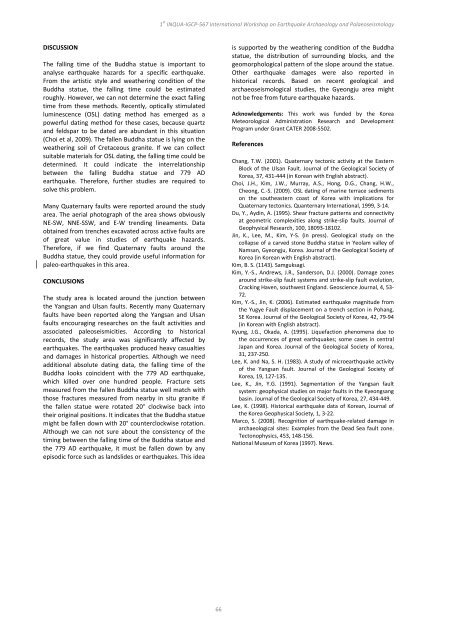Archaeoseismology and Palaeoseismology in the Alpine ... - Tierra
Archaeoseismology and Palaeoseismology in the Alpine ... - Tierra
Archaeoseismology and Palaeoseismology in the Alpine ... - Tierra
Create successful ePaper yourself
Turn your PDF publications into a flip-book with our unique Google optimized e-Paper software.
DISCUSSION<br />
The fall<strong>in</strong>g time of <strong>the</strong> Buddha statue is important to<br />
analyse earthquake hazards for a specific earthquake.<br />
From <strong>the</strong> artistic style <strong>and</strong> wea<strong>the</strong>r<strong>in</strong>g condition of <strong>the</strong><br />
Buddha statue, <strong>the</strong> fall<strong>in</strong>g time could be estimated<br />
roughly. However, we can not determ<strong>in</strong>e <strong>the</strong> exact fall<strong>in</strong>g<br />
time from <strong>the</strong>se methods. Recently, optically stimulated<br />
lum<strong>in</strong>escence (OSL) dat<strong>in</strong>g method has emerged as a<br />
powerful dat<strong>in</strong>g method for <strong>the</strong>se cases, because quartz<br />
<strong>and</strong> feldspar to be dated are abundant <strong>in</strong> this situation<br />
(Choi et al, 2009). The fallen Buddha statue is ly<strong>in</strong>g on <strong>the</strong><br />
wea<strong>the</strong>r<strong>in</strong>g soil of Cretaceous granite. If we can collect<br />
suitable materials for OSL dat<strong>in</strong>g, <strong>the</strong> fall<strong>in</strong>g time could be<br />
determ<strong>in</strong>ed. It could <strong>in</strong>dicate <strong>the</strong> <strong>in</strong>terrelationship<br />
between <strong>the</strong> fall<strong>in</strong>g Buddha statue <strong>and</strong> 779 AD<br />
earthquake. Therefore, fur<strong>the</strong>r studies are required to<br />
solve this problem.<br />
Many Quaternary faults were reported around <strong>the</strong> study<br />
area. The aerial photograph of <strong>the</strong> area shows obviously<br />
NE‐SW, NNE‐SSW, <strong>and</strong> E‐W trend<strong>in</strong>g l<strong>in</strong>eaments. Data<br />
obta<strong>in</strong>ed from trenches excavated across active faults are<br />
of great value <strong>in</strong> studies of earthquake hazards.<br />
Therefore, if we f<strong>in</strong>d Quaternary faults around <strong>the</strong><br />
Buddha statue, <strong>the</strong>y could provide useful <strong>in</strong>formation for<br />
paleo‐earthquakes <strong>in</strong> this area.<br />
CONCLUSIONS<br />
The study area is located around <strong>the</strong> junction between<br />
<strong>the</strong> Yangsan <strong>and</strong> Ulsan faults. Recently many Quaternary<br />
faults have been reported along <strong>the</strong> Yangsan <strong>and</strong> Ulsan<br />
faults encourag<strong>in</strong>g researches on <strong>the</strong> fault activities <strong>and</strong><br />
associated paleoseismicities. Accord<strong>in</strong>g to historical<br />
records, <strong>the</strong> study area was significantly affected by<br />
earthquakes. The earthquakes produced heavy casualties<br />
<strong>and</strong> damages <strong>in</strong> historical properties. Although we need<br />
additional absolute dat<strong>in</strong>g data, <strong>the</strong> fall<strong>in</strong>g time of <strong>the</strong><br />
Buddha looks co<strong>in</strong>cident with <strong>the</strong> 779 AD earthquake,<br />
which killed over one hundred people. Fracture sets<br />
measured from <strong>the</strong> fallen Buddha statue well match with<br />
those fractures measured from nearby <strong>in</strong> situ granite if<br />
<strong>the</strong> fallen statue were rotated 20° clockwise back <strong>in</strong>to<br />
<strong>the</strong>ir orig<strong>in</strong>al positions. It <strong>in</strong>dicates that <strong>the</strong> Buddha statue<br />
might be fallen down with 20° counterclockwise rotation.<br />
Although we can not sure about <strong>the</strong> consistency of <strong>the</strong><br />
tim<strong>in</strong>g between <strong>the</strong> fall<strong>in</strong>g time of <strong>the</strong> Buddha statue <strong>and</strong><br />
<strong>the</strong> 779 AD earthquake, it must be fallen down by any<br />
episodic force such as l<strong>and</strong>slides or earthquakes. This idea<br />
1 st INQUA‐IGCP‐567 International Workshop on Earthquake Archaeology <strong>and</strong> <strong>Palaeoseismology</strong><br />
66<br />
is supported by <strong>the</strong> wea<strong>the</strong>r<strong>in</strong>g condition of <strong>the</strong> Buddha<br />
statue, <strong>the</strong> distribution of surround<strong>in</strong>g blocks, <strong>and</strong> <strong>the</strong><br />
geomorphological pattern of <strong>the</strong> slope around <strong>the</strong> statue.<br />
O<strong>the</strong>r earthquake damages were also reported <strong>in</strong><br />
historical records. Based on recent geological <strong>and</strong><br />
archaeoseismological studies, <strong>the</strong> Gyeongju area might<br />
not be free from future earthquake hazards.<br />
Acknowledgements: This work was funded by <strong>the</strong> Korea<br />
Meteorological Adm<strong>in</strong>istration Research <strong>and</strong> Development<br />
Program under Grant CATER 2008‐5502.<br />
References<br />
Chang, T.W. (2001). Quaternary tectonic activity at <strong>the</strong> Eastern<br />
Block of <strong>the</strong> Ulsan Fault. Journal of <strong>the</strong> Geological Society of<br />
Korea, 37, 431‐444 (<strong>in</strong> Korean with English abstract).<br />
Choi, J.H., Kim, J.W., Murray, A.S., Hong, D.G., Chang, H.W.,<br />
Cheong, C.‐S. (2009). OSL dat<strong>in</strong>g of mar<strong>in</strong>e terrace sediments<br />
on <strong>the</strong> sou<strong>the</strong>astern coast of Korea with implications for<br />
Quaternary tectonics. Quanternary International, 1999, 3‐14.<br />
Du, Y., Ayd<strong>in</strong>, A. (1995). Shear fracture patterns <strong>and</strong> connectivity<br />
at geometric complexities along strike‐slip faults. Journal of<br />
Geophysical Research, 100, 18093‐18102.<br />
J<strong>in</strong>, K., Lee, M., Kim, Y‐S. (<strong>in</strong> press). Geological study on <strong>the</strong><br />
collapse of a carved stone Buddha statue <strong>in</strong> Yeolam valley of<br />
Namsan, Gyeongju, Korea. Journal of <strong>the</strong> Geological Society of<br />
Korea (<strong>in</strong> Korean with English abstract).<br />
Kim, B. S. (1143). Samguksagi.<br />
Kim, Y.‐S., Andrews, J.R., S<strong>and</strong>erson, D.J. (2000). Damage zones<br />
around strike‐slip fault systems <strong>and</strong> strike‐slip fault evolution,<br />
Crack<strong>in</strong>g Haven, southwest Engl<strong>and</strong>. Geoscience Journal, 4, 53‐<br />
72.<br />
Kim, Y.‐S., J<strong>in</strong>, K. (2006). Estimated earthquake magnitude from<br />
<strong>the</strong> Yugye Fault displacement on a trench section <strong>in</strong> Pohang,<br />
SE Korea. Journal of <strong>the</strong> Geological Society of Korea, 42, 79‐94<br />
(<strong>in</strong> Korean with English abstract).<br />
Kyung, J.G., Okada, A. (1995). Liquefaction phenomena due to<br />
<strong>the</strong> occurrences of great earthquakes; some cases <strong>in</strong> central<br />
Japan <strong>and</strong> Korea. Journal of <strong>the</strong> Geological Society of Korea,<br />
31, 237‐250.<br />
Lee, K. <strong>and</strong> Na, S. H. (1983). A study of microearthquake activity<br />
of <strong>the</strong> Yangsan fault. Journal of <strong>the</strong> Geological Society of<br />
Korea, 19, 127‐135.<br />
Lee, K., J<strong>in</strong>, Y.G. (1991). Segmentation of <strong>the</strong> Yangsan fault<br />
system: geophysical studies on major faults <strong>in</strong> <strong>the</strong> Kyeongsang<br />
bas<strong>in</strong>. Journal of <strong>the</strong> Geological Society of Korea, 27, 434‐449.<br />
Lee, K. (1998). Historical earthquake data of Korean, Journal of<br />
<strong>the</strong> Korea Geophysical Society, 1, 3‐22.<br />
Marco, S. (2008). Recognition of earthquake‐related damage <strong>in</strong><br />
archaeological sites: Examples from <strong>the</strong> Dead Sea fault zone.<br />
Tectonophysics, 453, 148‐156.<br />
National Museum of Korea (1997). News.



